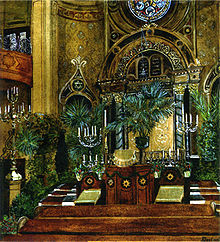Albrecht rose garden
Abraham (Albrecht) Rosengarten (also Albert Rosengarten, born January 5, 1810 in Kassel ; † August 15, 1893 in Wiesbaden ) was a German architect whose work had a major impact on synagogue construction in Germany and Austria-Hungary in the second half of the 19th century . Century had.
Origin and career
Rosengarten came from a Jewish family in Kassel and learned his trade in the 1830s at the building authority in Kassel. He spent 12 years in the Hessian government service and formed when abroad in 1839 in Paris (at Henri Labrouste ) and in 1841 in Rome on. He was the first Jewish architect in Germany to build synagogues and became known as the builder of the main synagogue in Kassel (1836–1838), the synagogue in Gudensberg in northern Hesse (1840–1843), as well as three brick-built synagogues (including the large synagogue Kohlhöfen ) and the guest and hospital on Danziger Strasse in Hamburg (1853–1857).
Kassel main synagogue
The large, two-story, three-aisled main synagogue in Kassel, which stood in Untere Königstrasse until 1938 and offered space for around 800 community members, was inaugurated in 1839 after three years of construction. According to the wish of the Jewish community of Kassel , it should be architecturally self-confident, but not stand out too much from its surroundings in terms of its construction. With its no-frills facade, the neo-Romanesque arches and the yellowish-white quarry stone, it blended harmoniously into the cityscape.
influence
With this building, Rosengarten created a new style in synagogue construction. He published his views and plans in the Wiener Allgemeine Bauzeitung in 1840 , which is why they are preserved to this day. Rosengarten's architecture was shaped by the desire to symbolize the integration of the Jews in the architectural style. The basilica was the model and thus the common root for Jews and Christians , and he considered the arched style to be best suited for synagogues. He opposed the Egyptian style because of its association with slavery, the neo-Gothic because of its all too obvious association with Christian architecture, and he was against copying classical temples. His work in Kassel became a style determinant for synagogues in Frankfurt / Main (Schützenstrasse, 1853) and Mannheim (1855). His influence on synagogue construction was particularly evident in the former Austria-Hungary . The synagogues of Pohořelice (Pohrlitz) (1855), Brno (Brno) (1855) and Jihlava (Iglau) (1863) in Moravia show his influence, as well as the New Synagogue in Gliwice (Gleiwitz) (1861) and the Great Synagogue in Plzeň (Pilsen) (1861) and the Linz Synagogue (1877).
Since most of the synagogues he built were destroyed, the synagogue in Gudensberg in Northern Hesse is probably one of the few, if not the only synagogue of Albrecht Rosengarten that has survived.
buildings
- 1836–1838: Main synagogue, Kassel
- 1840–1843: Synagogue, Gudensberg
- after 1842: Wilkens House, Hamburg, Alter Wall 56–58
- after 1842: residential building, Hamburg, Alsterdamm 3
- after 1842: Schumacher & Dahnert office building, Hamburg, Johannisstrasse 19
- 1851–1853: Schröderstift , Hamburg
- 1858: Hospital building, Hamburg, Danziger Strasse
- 1857–1859: Kohlhöfen Synagogue, Hamburg
- 1862: Schröder burial chapel, Hamburg, Petrikirchhof
- 1867–1869: Oberaltenstift, Hamburg, Mühlendamm
- 1872: Villa Horschitz, Hamburg, Harvestehuder Weg 8
- 1874: Alida Schmidt-Stift , Hamburg, Bürgerweide 23
Fonts
- (with L. Runge ): Architectural communications about Italy. A selection of the most interesting and valuable representations from the portfolios of the architects L. Runge and A. Rosengarten. Müller, Berlin undated [approx. 1847].
- The architectural styles. A brief, general description of the distinctive differences in architectural styles. Vieweg, Braunschweig 1857. Digitized
- Architectural images from Paris and London. Hamburg 1860.
literature
- Maros Borsky: Synagogue Architecture in Slovakia (PDF; 899 kB)
- Michael Eissenhauer : The Hamburg Housing Foundations of the 19th Century. "A memorial that has donated participating love ..." , Hans Christians Verlag, Hamburg 1987, ISBN 3-7672-1010-X .
- Wilhelm Melhop: Old Hamburg construction . Hamburg, 1925 (2nd edition), p. 226.
- Saskia Rohde: Albert Rosengarten (1809-1893). The beginnings of synagogue building by Jewish architects in Germany. In: Menora, Yearbook for German-Jewish History , 1993, pp. 228–258.
Web links
- The synagogue in Kassel
- Article on the inauguration of the new Kassel synagogue, 2005
- Article on the inauguration of the new Kassel synagogue
- Hans-Peter Klein: On the history of the Jewish community and the Gudensberg synagogue, 1995
- History of the former synagogue in Gudensberg
- Kulturhaus Synagoge, on the website of the city of Gudensberg
- Rose garden, Albrecht. Hessian biography. (As of January 23, 2020). In: Landesgeschichtliches Informationssystem Hessen (LAGIS).
Individual evidence
- ^ Wilhelm Melhop: Old Hamburg style of construction . Hamburg, 1925 (2nd edition), p. 226
- ^ Saskia Rohde: Rosengarten, Albert in The Jewish Hamburg: a historical reference work . Wallstein, Göttingen 2006, ISBN 3-8353-0004-0 , p. 218 .
| personal data | |
|---|---|
| SURNAME | Rose garden, Albrecht |
| ALTERNATIVE NAMES | Rose garden, Abraham; Rose garden, Albert |
| BRIEF DESCRIPTION | German architect |
| DATE OF BIRTH | January 5, 1810 |
| PLACE OF BIRTH | kassel |
| DATE OF DEATH | August 15, 1893 |
| Place of death | Wiesbaden |


